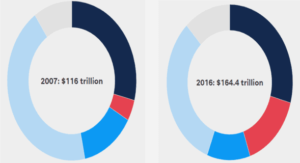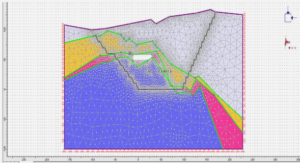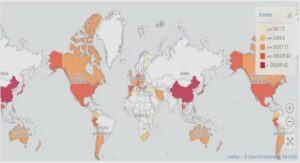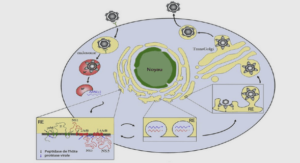AIDS-defining cancers
Between the pre- and late-cART periods, the 5-year survival significantly increased from 14% to 83% after visceral KS, from 36% to 92% after non-visceral KS and from 15% to 65% after NHL. In multivariable analyses, the 5-year HRs of death adjusted for age and sex improved significantly between the pre- and early-cART periods. The same improvement was observed after adjustment for all the other potential confounders with a HR=2.34 for visceral KS, a HR=3.19 for non-visceral KS and a HR=1.38 for NHL in the pre-cART period compared to the early-cART period. The 5-year HRs of death adjusted for age and sex significantly improved during the cART period. After adjustment for all confounders, the 5-year adjusted HR of death remained significantly improved for non-visceral KS (Ptrend=0.0312) and NHL (Ptrend <0.0001), and was no longer significantly improved for visceral KS, with a reduction by 2-fold in patients diagnosed with those cancers in the late-cART period compared to patients diagnosed with same cancers in the early-cART period. In the analyses restricted to the cART era and adjusted for viral load, the adjusted 5-year HRs of death remained significantly improved for both non-visceral KS (Ptrend=0.0269) and NHL (Ptrend <0.0001).
Non-AIDS defining cancers
Between the pre- and late-cART periods, the 5-year survival significantly increased from 48% to 87% after HL and from 17% to 19% after liver cancer. For lung and anal cancers, the difference in 5-year survival distributions was not statistically significant between calendar periods, with an overall 5-year survival of 16% after lung cancer and 65% after anal cancer during the whole study period.
In multivariable analyses, the 5-year HR of death after HL diagnosis didn’t change significantly between the pre-cART and early-cART periods, but indicate an improvement during the cART period (Ptrend =0.0023) with a HR=0.33 for cases diagnosed in the late-cART period compared to the early-cART period. For lung cancer, there was no improvement in the adjusted 5-year HR of death across calendar periods. The 5-year HR of death after liver cancer diagnosis didn’t change significantly between the pre-cART and early-cART periods, but improved during the cART period (Ptrend =0.0198) with a HR=0.52 for cases diagnosed in the late-cART period compared to the early-cART period. For anal cancer, a significant improvement of the 5-year HR of death was observed between the pre- and early-cART periods, with no significant change during the cART period. For the four cancers, results were similar both in the models with adjustment for age and sex and the fully adjusted models. In the analyses restricted to the cART period with adjustment for the viral load at cancer diagnosis, the adjusted 5 year HRs of death remained significantly improved (Ptrend =0.0071) for HL, and was no longer significantly improved for liver cancer.
Comparison with the general population
Table 3 shows 5-year survival in HIV-infected and the general population for NHL, Lung, HL, liver and anal cancers diagnosed in 2001-2004. The age and sex standardized survival after a hematological malignancy in the general population was higher than survival among HIV-infected individuals for both NHL and HL. For solid tumors, 5-year survivals in HIV-infected individuals were close to age and sex standardized survival in the general population.
DISCUSSION
This study showed an improved survival after KS diagnosis, whether visceral or non-visceral, with the advent of cART. Survival continued to improve after non-visceral KS over the cART period until 2009, while survival after visceral KS was mainly owing to the increase in the proportion of patients with restored CD4 cell count. Survival improved with the advent of cART after NHL diagnosis, with further improvement during the cART period. For HL, while there was no improvement in survival with the advent of cART, survival improved over the cART period. For solid tumors, there was an improvement in survival only after anal cancer diagnosis between the pre- and early-cART periods. During cART period, the survival improved very modestly only after liver cancer and was stable after lung and anal cancers. For hematological malignancy cases diagnosed in 2001-2004, survival in HIV-infected individuals was less favorable than in the general population, while survival among HIV-infected individuals was similar to that in the general population for solid tumors diagnosed in 2001-2004.
The major strengths of this study were the long study period of nearly 20 years including 15 years of use of cART, the inclusion of a large number of cancer cases allowing studying survival after each cancer separately, the inclusion of all HIV-infected individuals and not only patients with AIDS, and the availability of many covariates that influence the prognosis of HIV-infected individuals. The relationship between the evolution of survival after cancer diagnosis and the evolution of cancer stage at diagnosis over time could not be evaluated because these data were not available. In the absence of organized mass screening program in France for the studied cancers, earlier diagnosis in the recent periods than in the pre-cART period is unlikely to influence our results.
The improvement in survival after KS diagnosis is consistent with other studies that reported comparison of survival after KS between the pre- and post-cART periods (7–9). Interestingly, survival improved after both visceral and non-visceral KS. During the cART period, the improvement in survival after visceral KS diagnosis was explained by higher proportion of HIV-infected individuals with restored CD4 cell count over time.
As observed in other studies, survival after NHL diagnosis improved between the pre- and early-cART periods (9–15), and continued to improve during the cART period until 2009. For HL, survival was stable between the pre- and post-cART periods, but improved during the cART period. The stability of survival with the advent of cART found here was in contrast with the improvement showed in a study from a single institution center in France, likely because this is a center that is specialized in the treatment of lymphomas in HIV-infected individuals and that uses the same cancer treatment protocols as for non HIV-infected individuals for a long time (16). Two prior studies showed no change in survival in the cART period after NHL and HL (24,25) probably due to insufficient statistical power or to studying HL and NHL combined together. Improved survival following a hematological malignancy found here was not explained by the evolution of the characteristics of HIV-infected individuals over time but by a calendar period effect, likely related to the increased tolerance to chemotherapy and increased adherence to cancer treatment protocols in HIV-infected individuals. Despite the clear trend of improved survival following a hematological malignancy, a marked difference was observed between the HIV-infected and general population for cases diagnosed in 2001-2004, confirming the results of previous studies (15,19,24). Although the improvement in survival could be related to better access to cancer treatment over time, there is still a higher likelihood of sub-optimal management of cancer in HIV-infected individuals in the recent periods (26), related to the fact that people infected with HIV do not receive the same number of cycles or the same doses of chemotherapy than those not infected with HIV.
The survival trends after solid tumors diagnosis were different depending on cancer type. For lung cancer, our analysis based on a large number of cases (n=460) showed a stability in survival over a long period (1992-2009), with an overall survival of 15%. This result was similar to that observed by others during years 1980-2000 (15). Stability of survival after lung cancer diagnosis could be explained by the lack of significant improvement in the management of this cancer over the study period. As in other studies (27,28), survival in HIV-infected patients was close to that in the general population for cases diagnosed in 2001-2004, reflecting a poor prognosis in both HIV-infected individuals and the general population (22).
The survival following liver cancer didn’t change with the advent of cART but improved very modestly during the cART period. The improvement during the cART period was mainly explained by the increase in the proportion of patients with controlled viral load over time. To our knowledge, the evolution of survival over time after the diagnosis of liver cancer has never been assessed before. For cases diagnosed in 2001-2004, survival in HIV-infected individuals was close to that in the general population; this was in agreement with a previous study (29).
Our results on anal cancer survival confirmed those of a previous study that showed significant improvement between the pre- and early cART periods (15), as the 5-year HR of death in the current analysis was 3 fold higher in individuals diagnosed with anal cancer in 1992-1996 compared with those diagnosed with this cancer in 1997-2000. Another study showed no such change probably due to the small number of cases (n=26) (18). Nevertheless, we found a stability of the survival over the cART period, with a survival similar to that in the general population for cases diagnosed in 2001-2004 as previously shown (30).
In conclusion, we showed a marked increase in the survival among HIV-infected individuals after a diagnosis of KS mainly explained by the increasing proportion of patients with restored CD4 cell count over time for visceral KS. For other malignancies, the evolution of survival depended on cancer type. There was an improved survival after hematological malignancies (NHL and HL) diagnosis with a survival remaining poorer than that in the general population. Even if survival was different after hematological malignancies between the HIV-infected and general population for cases diagnosed in 2001-2004, there was a considerable improvement in the recent cART period suggesting that survival in HIV-infected individuals will probably become closer to that in the general population over time. This highlights the need to optimize the treatment of hematological malignancies in HIV-infected individuals. For solid tumors, there was a modest improvement in survival after liver cancer diagnosis and stability after lung and anal cancer diagnosis over the cART period, with survival similar to that in the general population for cases diagnosed in 2001-2004, although prognosis remains poor after lung and liver cancer diagnosis.
Acknowledgments. We thank all the participants and research assistants of the French Hospital Database on HIV (FHDH ANRS-CO4) and the French network of cancer registries (FRANCIM). Author contributions. D. C. and S. G. designed the study. M. H. performed the statistical analyses. M. H., D. C., and S. G. interpreted the data and wrote the manuscript. All authors read and critically commented on the paper.
Financial support. M.H. is supported by a doctoral contract from Sorbonne Universités UPMC Paris Univ 06. The FHDH is supported by the Agence Nationale de Recherche sur le SIDA et les hépatites virales (ANRS), INSERM, and the French Ministry of Health.
Conflicts of interest. All authors declare no conflict of interest, although several members of the group have, at some stage in the past, received funding from a variety of pharmaceutical companies for research, travel grants, speaking engagements or consultancy fees.






